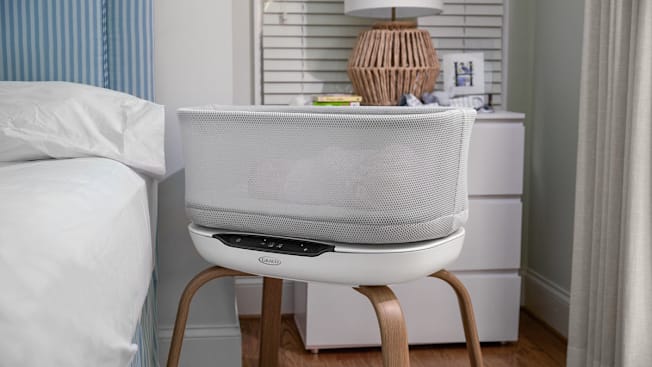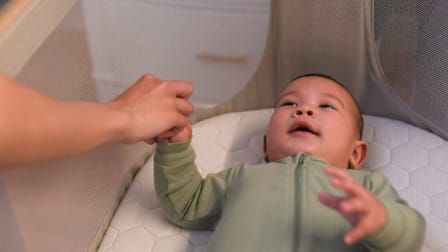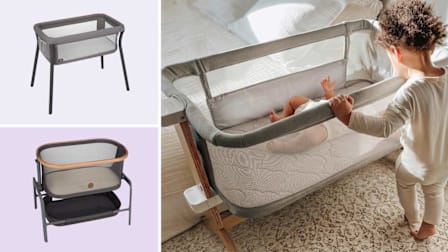Best Smart Bassinets of 2026, Lab Tested and Reviewed
See the ones that stood out in CR’s tests for ease of use, design, and tech-forward features
When you shop through retailer links on our site, we may earn affiliate commissions. 100% of the fees we collect are used to support our nonprofit mission. Learn more.

Can you actually hack your baby’s sleep? That’s the question most smart bassinets seem to be trying to answer. Unlike traditional bassinets, these technology-forward baby beds come with features that allow you to adjust motion, vibration, white noise, night lights, and sound, all in the name of helping your baby sleep. Some, like the Maxi-Cosi Starling, the Cradlewise, or the Snoo, can recognize your baby’s cries and respond with shushing and rocking. Other smart bassinets may alert you when your baby cries, or turn on calming sounds and motion to help settle your little one. Some even analyze your baby’s sleep habits and point out patterns.
“Smart bassinets, some of which detect restlessness or crying and soothe the baby back to sleep, may seem like an answer to sleep-deprived parents’ prayers,” says Joan Muratore, the engineer who leads CR’s bassinet testing. “They offer different levels of motion and sound, raising the chances that you’ll find the sweet spot that helps your little one—and therefore, you—get some rest.”
How CR Tests Smart and Soothing Bassinets
In our lab tests, Muratore led a team of product testers who assessed each bassinet for the following criteria over the span of several weeks:
Ease of assembly: How many steps does it take to assemble the bassinet? How many pieces or tools are required? We wanted to know whether this was a one-person job or required more hands.
Convenience: What kind of storage is offered for diapers or extra pajamas? Smart bassinets aren’t known for their portability, but we looked at how easy it was to lift and carry the bassinet from room to room. We also looked at cleaning and upkeep, such as whether a bassinet sheet is included, and if the bassinet fabric itself was machine-washable for those inevitable diaper leaks and blowouts.
Design: We checked the breathability of the side walls, looking for materials that promote airflow in the baby’s sleep environment, such as mesh panels. We also looked at whether the frame height was adjustable and how easy it was to access a baby.
Features: We looked at the types of features the bassinet offered, including those for motion, sound, or automated soothing. For bassinets with sound features, we looked at how loud the music or sounds could get because even white noise played too loudly can be harmful to a baby’s ears.
Safety: CR testers made sure that each bassinet met federal safety guidelines, such as using an inclinometer to make sure the sleeping surface never reached an incline of 10 degrees or greater, which can be dangerous to a baby’s airflow, among other assessments. We also checked the firmness of the sleeping surface and how snugly the mattress fit.
Best Smart and Soothing Bassinets and Smart Cribs
Looking for more smart bassinet ratings and reviews? Other smart and soothing bassinet models we tested include the Fisher-Price Soothing Motions Bassinet, the Delta Children Sweet Dreams Bassinet, the Simmons Kids Shooting Star Bassinet, and the Delta Children Rocking Bedside Bassinet. See CR’s full ratings here.
Curious about traditional or non-smart bassinets, or travel bassinets that are designed to be portable? We’ve got those, too.
Do You Need a Smart Bassinet?
While a bassinet can be useful, especially in the early months, deciding whether to add a smart bassinet to your baby registry depends on what you’re looking for when it comes to your baby’s sleep space. A traditional bassinet with a firm, flat surface might be all you need, but extra features like rocking, shushing, or white noise can be helpful if you’re looking for more tools to settle your baby—and give you a little extra rest, too.
Smart bassinets can vary widely when it comes to the level of technology they offer. Here’s what to look for:
Soothing features: Smart bassinets tend to include a range of vibrations, sounds, and motion. Some will rock, some will play lullabies, and some will have “shushing” or white noise, enabling you to try a wide variety of soothing techniques to help lull your little one to sleep.
Audio or video monitoring: Several bassinets in our tests come with a built-in baby monitor, whether audio-only or video, that lets you check in on whether those whimpers mean a diaper change is needed or if your baby is just stirring between snooze cycles.
Responsive technology: In addition to monitoring, some bassinets can listen to your baby’s cries and respond automatically, while others will notify you of your little one’s cries and let you choose how to respond. One smart bassinet on our list, the Maxi-Cosi Starling, has AI-enabled features that can translate your baby’s cries, giving you even more information as to what they might need.
Connected apps: Many of the smart bassinets we tested come with a companion app that allows you to control various features directly from your phone. These apps may also provide sleep tracking insights, soothing response reports, and other analytics, which can help you find patterns and figure out what works best for your little one. But this connectivity can also raise privacy concerns, Muratore says. For example, your baby’s sleep data might be collected and used by the company to develop future technologies. If privacy is a concern for you, consider reaching out to the manufacturer’s customer service to understand how your data is used and stored. Note that CR hasn’t evaluated the privacy or security of the smart bassinet apps included in our ratings.
While smart bassinets are designed to help babies and parents sleep better, it’s possible that all the information generated from monitoring and sleep analysis could trigger overwhelm or anxiety in parents. It’s similar to how sleep tracker use by adults can cause a hyperfixation on hitting your numbers, a phenomenon known as orthosomnia. In the early days of new parenthood, when you’re trying to learn everything you can about this tiny new human who lives with you, it’s easy to rely on devices or apps to feed your need for information. But if logging or tracking your baby’s sleep starts to make you feel stressed or anxious, it could be a reason to scale back.
“New tools for tracking sleep patterns for your baby can be useful in getting a clearer picture of when and how much your baby sleeps. It may reassure you that they are getting more sleep than you thought or that a certain bedtime ritual keeps them awake longer than another,” says Nancy Cowles, a child product safety expert and former executive director of the nonprofit Kids in Danger. “But if they aren’t helpful, don’t feel obligated to use them. Adding stress to your life isn’t going to help either of you sleep better.”
There’s also the question of what happens if you’re traveling or visiting family and can’t bring your smart bassinet. “Most smart bassinets aren’t easily portable, so your baby may have a restless night without the soothing they’ve become accustomed to,” Muratore. says.
When Should a Baby Stop Using a Bassinet?
Babies should be moved out of their bassinet and into a crib by the time they’ve reached the product’s weight limit, which is typically 20 pounds, or once they’re rolling over or showing signs of pushing up on their hands and knees, which tends to be between 3 and 6 months of age, Cowles says. They should then use a larger sleeping space with a firm, flat mattress, like a crib or play yard.
Transitioning from a smart bassinet to a traditional crib can be a little tricky, although it’s worth noting that some babies have a difficult time transitioning even from a standard bassinet, according to Cowles. “Parents should resist the urge to add comfort items to the crib such as pillows or blankets, as these pose safety concerns,” she says. “Instead, create a new bedtime routine in their new sleeping space that provides comfort to the baby, such as patting their back or playing soft music.” Some smart bassinets come with specific instructions about weaning that are designed to promote a smooth transition to the crib, too.
What to Know About Bassinet Safety
The AAP says that a bassinet, crib, or portable play yard can provide a safe sleeping environment for your baby and should be used for every nap and nighttime sleep. These sleep surfaces should be flat and firm and have no other objects or blankets placed inside.
When you’re looking at purchasing a bassinet, here are a few safety factors to consider:
Check out the bassinet’s side walls. Do they seem breathable? “Look for mesh side walls. If not complete mesh, it should at least be mesh up to the height where your baby’s face will be as they lie inside the bassinet. If the sidewalls are solid fabric—or worse, multiple layers of fabric—give that bassinet a pass,” Muratore says.
Examine the included mattress. Some manufacturers don’t include a sheet and offer just a vinyl-covered foam mattress pad. “That seems uncomfortable. If the baby sweats in warmer weather, the pad can get sticky and damp,” Muratore says. “The plastic pad may also encourage parents or other caregivers to put a loose blanket or cloth beneath the baby for their perceived comfort.” Don’t do it, Muratore says. “No loose fabric, no pillows, no blankets in the bassinet—they create potential hazards to your baby.”
Avoid cantilevered bassinets. CR recently reported on two types of cantilevered bassinets that have a sleeping surface only supported on one side, which has led to newborns rolling over from their backs onto their stomachs, a risk for sudden infant death syndrome, or SIDS.
Make sure to also follow these safe sleep guidelines when using a bassinet:
- Always place your baby down on their back in their own sleeping space, with no other people or pets.
- Babies should sleep on a firm, flat—not inclined—surface. Inclines of 10 degrees or greater can restrict your baby’s airflow.
- Use only a fitted sheet in your baby’s sleeping space.
- Keep toys, blankets, bumpers, pillows or nursing pillows, baby loungers, sleep positioners, and other items out of the bassinet. These items can potentially suffocate your baby. (Bumpers, in fact, are banned under the Safe Sleep for Babies Act.)
- Do not use weighted sleep sacks.
- If your baby falls asleep in a child car seat, a stroller, a swing, or an infant carrier, you should move them to a firm sleep surface on their back as soon as possible.
- If you decide to use the white noise or sound features available on some of the bassinets we reviewed, use the lowest possible setting for a brief time, and if possible, position your baby’s head on the opposite side of the bassinet from where the speaker is placed.






























